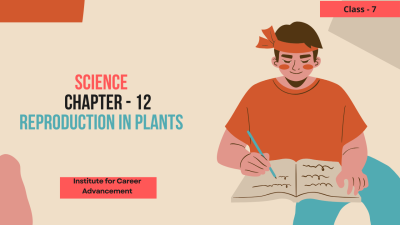| Expiry period |
Lifetime |
|
|
| Made in |
English |
|
|
| Last updated at |
Wed Nov 2024 |
|
|
| Level |
Beginner |
|
|
| Total lectures |
0 |
|
|
| Total quizzes |
0 |
|
|
| Total duration |
Hours |
|
|
| Total enrolment |
 0
0 |
|
|
| Number of reviews |
0 |
|
|
| Avg rating |
|
|
|
| Short description |
Plants reproduce through two main methods: sexual and asexual reproduction. Sexual reproduction involves the fusion of male and female gametes, usually through flowers and seeds. Asexual reproduction occurs without seeds and involves vegetative propagation through structures like bulbs, tubers, and runners. This topic explores the structures and processes involved in both types of reproduction, emphasizing pollination, fertilization, seed formation, and the role of flowers in the plant life cycle. Understanding plant reproduction is crucial for agricultural practices, biodiversity conservation, and ecosystem stability.
উদ্ভিদ দুটি প্রধান পদ্ধতির মাধ্যমে প্রজনন করে: যৌন এবং অযৌন প্রজনন। যৌন প্রজননে সাধারণত ফুল এবং বীজের মাধ্যমে পুরুষ এবং মহিলা গ্যামেটের সংমিশ্রণ জড়িত। অযৌন প্রজনন বীজ ছাড়াই ঘটে এবং বাল্ব, কন্দ এবং রানার্সের মতো কাঠামোর মাধ্যমে উদ্ভিদের বংশবিস্তার জড়িত। এই বিষয়টি উভয় ধরণের প্রজননের সাথে জড়িত কাঠামো এবং প্রক্রিয়াগুলি অন্বেষণ করে, পরাগায়ন, নিষিক্তকরণ, বীজ গঠন এবং উদ্ভিদের জীবনচক্রে ফুলের ভূমিকার উপর জোর দেয়। উদ্ভিদের প্রজনন বোঝা কৃষি অনুশীলন, জীববৈচিত্র্য সংরক্ষণ এবং বাস্তুতন্ত্রের স্থিতিশীলতার জন্য অত্যন্ত গুরুত্বপূর্ণ। |
|
|
| Outcomes |
- Here are the expected outcomes or learning objectives: Learning Objectives: Understanding Plant Reproductive Structures: Identify and describe the parts of a flower (sepals, petals, stamens, pistil). Explain the function of each flower part in the reproductive process. Processes of Sexual Reproduction: Describe pollination and the transfer of pollen from the anther to the stigma. Explain fertilization as the fusion of male gametes (pollen) with female gametes (ovules) to form seeds. Seed Formation and Germination: Outline the stages of seed development from fertilization to seed maturity. Understand seed germination and the conditions necessary for seeds to sprout and grow into new plants. Types and Examples of Asexual Reproduction: Identify various methods of asexual reproduction in plants (e.g., runners, tubers, bulbs, cuttings). Provide examples of plants that reproduce asexually and explain the advantages of each method. Life Cycle of Plants: Illustrate the alternation of generations in plants, including the sporophyte and gametophyte phases. Explain how spores and gametes are produced and their roles in the plant life cycle. Significance of Plant Reproduction: Discuss the ecological importance of plant reproduction in maintaining biodiversity and ecosystem stability. Explore the economic significance of plant reproduction in agriculture, horticulture, and industry.
- এখানে প্রত্যাশিত ফলাফল বা শেখার উদ্দেশ্য রয়েছে: শিক্ষার উদ্দেশ্য: উদ্ভিদের প্রজনন কাঠামো বোঝা: একটি ফুলের অংশগুলি সনাক্ত করুন এবং বর্ণনা করুন (সেপাল, পাপড়ি, পুংকেশর, পিস্টিল)। প্রজনন প্রক্রিয়ায় প্রতিটি ফুলের অংশের কাজ ব্যাখ্যা কর। যৌন প্রজননের প্রক্রিয়া: পরাগায়ন এবং পরাগ থেকে কলঙ্কে পরাগ স্থানান্তর বর্ণনা কর। বীজ গঠনের জন্য স্ত্রী গ্যামেট (ডিম্বাণু) এর সাথে পুরুষ গ্যামেট (পরাগ) এর সংমিশ্রণ হিসাবে নিষিক্তকরণ ব্যাখ্যা করুন। বীজ গঠন ও অঙ্কুরোদগমঃ নিষিক্তকরণ থেকে বীজ পরিপক্কতা পর্যন্ত বীজ বিকাশের পর্যায়গুলিকে রূপরেখা দাও। বীজের অঙ্কুরোদগম এবং বীজের অঙ্কুরোদগম এবং নতুন গাছে বৃদ্ধির জন্য প্রয়োজনীয় শর্তগুলি বুঝুন। অযৌন প্রজননের প্রকার ও উদাহরণ: উদ্ভিদে অযৌন প্রজননের বিভিন্ন পদ্ধতি চিহ্নিত করুন (যেমন, রানার, কন্দ, বাল্ব, কাটিং)। অযৌনভাবে প্রজনন করে এমন উদ্ভিদের উদাহরণ দিন এবং প্রতিটি পদ্ধতির সুবিধা ব্যাখ্যা করুন। উদ্ভিদের জীবনচক্রঃ স্পোরোফাইট এবং গ্যামেটোফাইট পর্যায় সহ উদ্ভিদের প্রজন্মের পরিবর্তনের চিত্রিত করুন। স্পোর এবং গ্যামেট কিভাবে উৎপন্ন হয় এবং উদ্ভিদের জীবনচক্রে তাদের ভূমিকা ব্যাখ্যা কর। উদ্ভিদ প্রজননের তাৎপর্য: জীববৈচিত্র্য এবং বাস্তুতন্ত্রের স্থিতিশীলতা বজায় রাখতে উদ্ভিদ প্রজননের পরিবেশগত গুরুত্ব আলোচনা কর। কৃষি, উদ্যানপালন এবং শিল্পে উদ্ভিদের প্রজননের অর্থনৈতিক তাত্পর্য অন্বেষণ করুন।
|
|
|
| Requirements |
- Plant reproduction provides insights into the life cycles of plants, including how they reproduce, grow, and mature. This knowledge helps us understand the stages of plant development and the factors that influence their growth. Knowledge of plant reproduction is essential for agriculture. It informs practices such as crop breeding, seed production, and cultivation techniques that ensure sufficient food production and sustainable farming practices.
- উদ্ভিদের প্রজনন উদ্ভিদের জীবনচক্রের অন্তর্দৃষ্টি প্রদান করে, যার মধ্যে তারা কীভাবে প্রজনন, বৃদ্ধি এবং পরিপক্ক হয়। এই জ্ঞান আমাদের উদ্ভিদের বিকাশের পর্যায়গুলি এবং তাদের বৃদ্ধিকে প্রভাবিত করার কারণগুলি বুঝতে সাহায্য করে। উদ্ভিদের প্রজনন জ্ঞান কৃষির জন্য অপরিহার্য। এটি শস্য প্রজনন, বীজ উৎপাদন, এবং চাষাবাদের কৌশলগুলির মতো অনুশীলনগুলিকে অবহিত করে যা পর্যাপ্ত খাদ্য উৎপাদন এবং টেকসই চাষ পদ্ধতি নিশ্চিত করে।
|
|
|


 0
0 